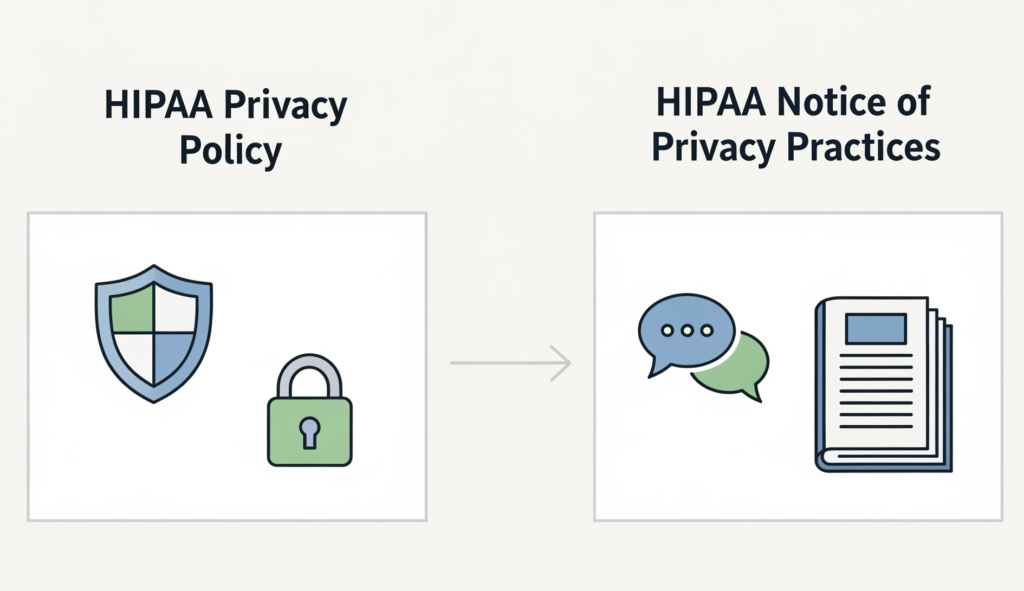HIPAA Privacy Policy vs. HIPAA Notice of Privacy Practices
When it comes to HIPAA compliance, many healthcare organizations and professionals confuse the HIPAA Privacy Policy with the HIPAA Notice of Privacy Practices (NPP). While both documents deal with patient privacy and protected health information (PHI), they serve different purposes. Understanding the distinction is essential for healthcare providers, business associates, and patients alike.
In this article, we’ll break down the differences, similarities, and compliance requirements for each.
What Is a HIPAA Privacy Policy?
A HIPAA Privacy Policy is an internal document created and maintained by a covered entity or business associate. It establishes how an organization safeguards patient information, who has access to PHI, and the procedures for handling, storing, or sharing it.
Key Features of HIPAA Privacy Policies:
-
Internal Use Only – Not distributed to patients.
-
Defines Staff Responsibilities – Outlines roles and access levels for employees.
-
Compliance Framework – Guides staff on meeting HIPAA Privacy Rule standards.
-
Customized Policies – Tailored to each organization’s operations.
-
Covers Breach Protocols – Defines how incidents are reported and managed.
In short, a HIPAA Privacy Policy ensures that all internal processes align with federal privacy regulations.
What Is a HIPAA Notice of Privacy Practices (NPP)?
The Notice of Privacy Practices (NPP) is a patient-facing document required under the HIPAA Privacy Rule. It explains how a healthcare provider or health plan may use or disclose patient information, and it informs patients about their rights.
Key Features of the HIPAA NPP:
-
External Communication – Provided to patients, typically during their first visit.
-
Explains PHI Use – How information can be shared for treatment, payment, or operations.
-
Outlines Patient Rights – Includes access to records, request for amendments, and privacy restrictions.
-
Acknowledgement Required – Patients must sign a receipt confirming they received the notice.
-
Standard Language – Must follow the format and content required by HIPAA.
The NPP empowers patients by ensuring transparency and building trust between providers and individuals.
HIPAA Privacy Policy vs. HIPAA Notice of Privacy Practices: The Main Differences
| Feature | HIPAA Privacy Policy | HIPAA Notice of Privacy Practices (NPP) |
|---|---|---|
| Audience | Internal (staff, employees, contractors) | External (patients, plan members) |
| Purpose | Establishes internal compliance procedures | Educates patients about rights & PHI use |
| Requirement | Must exist but not shared with patients | Must be provided to every patient |
| Format | Organization-specific | Standardized by HIPAA guidelines |
| Access | Restricted to workforce | Given to patients, posted on websites & offices |
Why Both Are Important for HIPAA Compliance
-
HIPAA Privacy Policy ensures that healthcare organizations internally comply with federal regulations and protect PHI at every step.
-
HIPAA Notice of Privacy Practices ensures that patients are informed about their rights and how their health data will be used.
Without both, healthcare providers risk fines, legal issues, and loss of patient trust.
Best Practices for Organizations
-
Keep Policies Updated – Review and revise privacy policies regularly.
-
Train Employees – Ensure staff understands and follows internal policies.
-
Distribute NPPs Properly – Provide to patients, post on websites, and display in offices.
-
Document Everything – Maintain proof of patient acknowledgements and staff training.
Final Thoughts
While the HIPAA Privacy Policy and the Notice of Privacy Practices (NPP) may sound similar, they serve distinct roles in HIPAA compliance. One is an internal safeguard, and the other is an external communication tool. Together, they form the foundation of privacy protection in healthcare.
Healthcare organizations must ensure they have both documents in place—and that staff and patients clearly understand their purpose.
